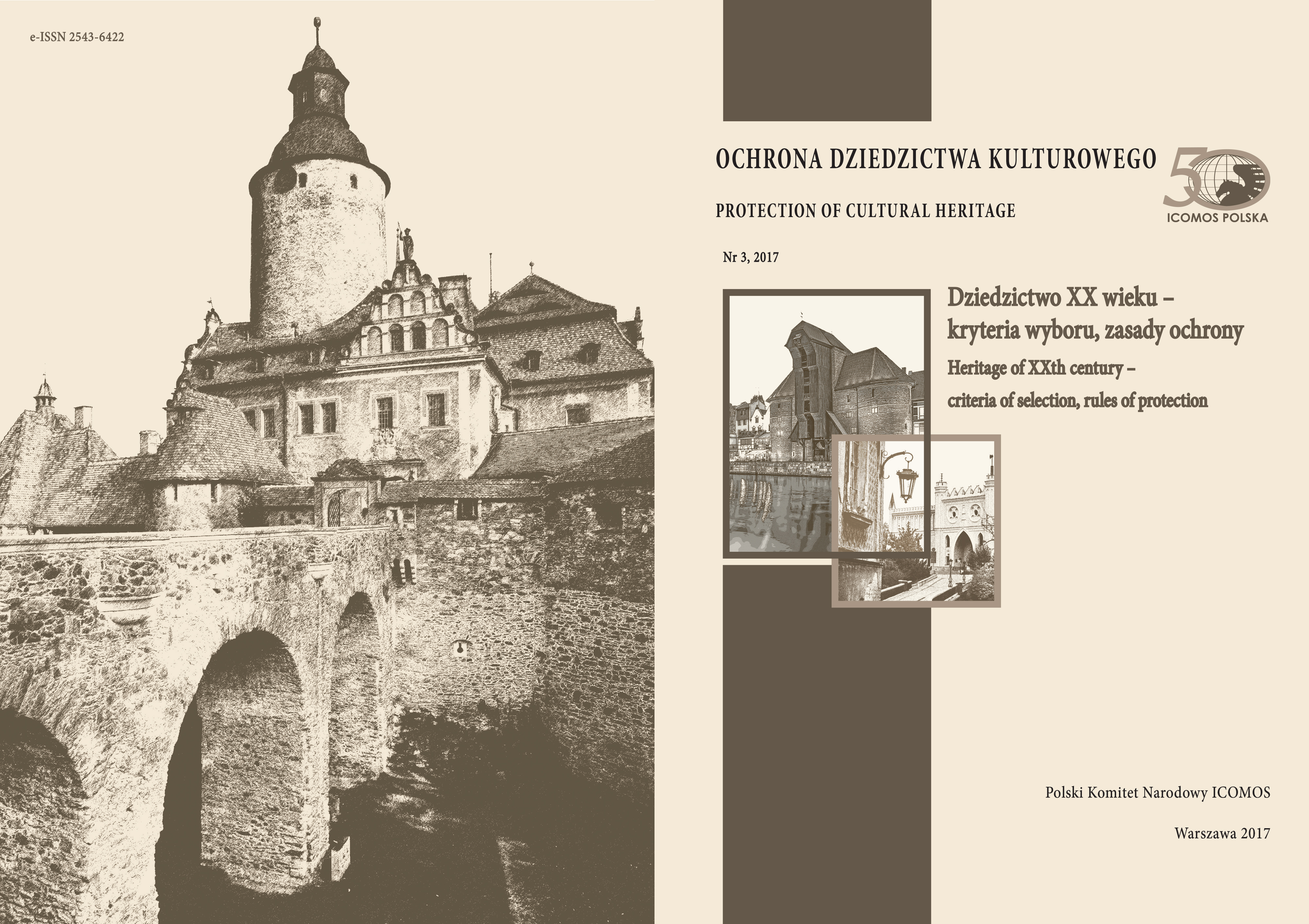Conservation issues and assumptions for the protection of objects of the former KL Auschwitz-Birkenau
Article Sidebar
Open full text
Issue No. 3 (2017)
-
Protection of contemporary cultural goods in Lodz planning documents - defining the resource and rules of protection
Maria Dankowska7-18
-
Conservation issues and assumptions for the protection of objects of the former KL Auschwitz-Birkenau
Jolanta Banaś-Maciaszczyk, Rafał Pióro19-28
-
Copyright protection of the 20th century cultural heritage
Wojciech Kowalski29-44
-
The legacy of post-war architecture in Poland as a record of political, social and economic changes
Małgorzata Rozbicka45-68
-
Protection of cultural goods in the 2nd half of the XXth century in Silesia. Urban design, architecture, sculpture, mural
Helena Jadwiszczok-Molencka, Jacek Molencki69-85
-
How young can a monument be? The normative premises of stating the "validity" of immovable monuments
Marek Świdrak87-94
-
Authenticity versus sharing. Boundaries of compromises in the preservation of the former Auschwitz-Birkenau camp
Anna Łopuska95-106
-
Evaluation of the value of modernism monuments from the 1st half of the XXth century. Proposals of the classification methods
Jakub Lewicki107-124
-
Modernism as a particularly important Polish 20th century heritage. Criteria for selection and protection of modernist resource on the example of Stalowa Wola architecture
Grażyna Stojak125-131
-
Searching for criteria for the evaluation of modern wall paintings in historic churches in Poland
Małgorzata Korpała133-145
-
Industrial heritage - unwated heritage - unknown heritage
Jacek Dąbrowski147-160
-
Legacy of modernity in Japan - categories of valuation and examples
Waldemar J. Affelt161-178
-
Monuments of modernism as a defined resource of architectural heritage in the context of post-war facilities protection
Maciej Czarnecki179-186
Main Article Content
DOI
Authors
Abstract
The article presents a scale and challenges of the protection and preservation of the former German Nazi Auschwitz-Birkenau concentration and extermination camp.
The sequence of actions taken in order to preserve the site from the moment of the museum foundation in 1947, through establishing the professional conservation laboratories in 2003, to the first works carried out within the extensive long-term conservation program (Master Plan for Preservation) in the period 2012–2016, has been described in the synthetic and cross-sectional manner.
The authors point to main directions and principles, the rules that were applied by the following generations responsible for preservation of the former camp. They specify also the current conservation guidelines formed on the basis of the experience from the works performed in the period 1947–2002, that were later revised and specified by the team of certified conservators employed by the museum.
The article indicates the most significant events related to the protection and preservation of the former camp and mentions some selected conservation projects that were carried out on the basis of the present conservation guidelines.
Auschwitz is an example which shows that thanks to the early steps taken and later consistently implemented, the authenticity of this place has been successfully maintained. Those actions enabled also to develop mechanisms for long-term planned conservation.
Keywords:
References
Banaś J., Cyrulik E., Papis A., Pióro R., Programy konserwatorskie dla bloków o nr inw. A-2 i A-3, Część pierwsza – Wprowadzenie, Dział Konserwacji PMA-B w Oświęcimiu, 2007.
Łopuska A., Założenia konserwatorskie dla baraków murowanych na odcinku BI dawnego KL Auschwitz II-Birkenau, Oświęcim 2014.
Rymaszewski B., Granice ingerencji muzealnej i konserwatorskiej w Muzeum i Miejscu Pamięci Auschwitz [w:] K. Marszałek (red.), Chronić dla przyszłości, Oświęcim 2003.
Smrek W., Dziesięć lat prac konserwatorskich w Państwowym Muzeum Auschwitz-Birkenau [w:] K. Marszałek (red.) Chronić dla przyszłości, Oświęcim 2003.
Ustawa z dnia 2 lipca 1947 r. o upamiętnieniu męczeństwa Narodu Polskiego i innych Narodów w Oświęcimiu, Dz. U. Nr 52, poz. 265.
Article Details
Abstract views: 351
Jolanta Banaś-Maciaszczyk, Auschitz-Birkenau Memorial and Museum
konserwator zabytków. Absolwentka kierunku Konserwacja i Restauracja Dzieł Sztuki
w Instytucie Zabytkoznawstwa i Konserwatorstwa Uniwersytetu Mikołaja Kopernika w Toruniu
oraz Podyplomowych Studiów Konserwacji Zabytków Architektury i Urbanistyki Politechniki
Krakowskiej.
W Państwowym Muzeum Auschwitz-Birkenau od 2004 r, od 2006 r. Kierownik Sekcji
Konserwatorskiej, a następnie od 2009 kierownik Działu Konserwacji. W Muzeum odpowiada za
działania związane z konserwacją wszystkich obiektów zachowanych po KL Auschwitz-Birkenau;
budynków, terenu wraz z zachowaną infrastrukturą, historycznej zieleni a także muzealiów
i archiwaliów.
Rafał Pióro, Auschitz-Birkenau Memorial and Museum
wicedyrektor Państwowego Muzeum Auschwitz-Birkenau w Oświęcimiu odpowiedzialny m.in. za
zachowanie autentyczności Miejsca Pamięci, zbiory i archiwum; wiceprezes Fundacji Auschwitz-Birkenau.
Ukończył dwa kierunki konserwatorskie na Uniwersytecie Toruńskim (Ochrona Dóbr Kultury
oraz Konserwacja i Restauracja Dzieł Sztuki). W latach 2002/2003 w Państwowym Muzeum Auschwitz-
Birkenau stworzył od podstaw pracownię konserwatorską i został jej kierownikiem. W 2006 roku został
kierownikiem Działu Konserwacji, a w roku 2009 wicedyrektorem Muzeum. Wówczas zainicjował
i współtworzył Globalny Plan Konserwacji dla całego Miejsca Pamięci.







